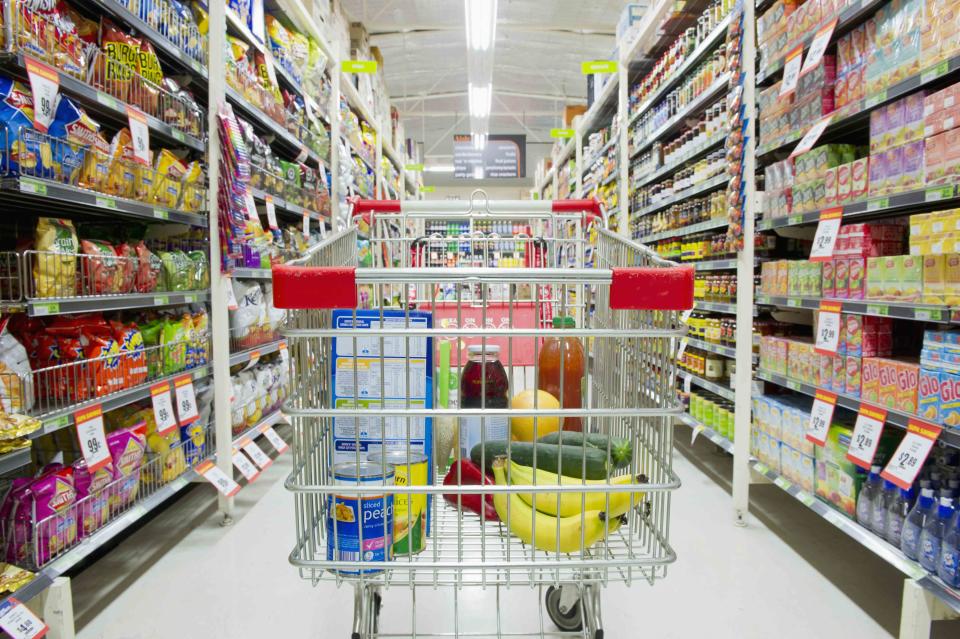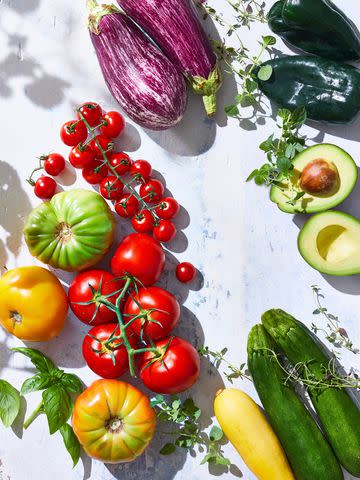Grocery Prices Are Set to Shift Again in 2024—Here’s What to Expect
Will grocery prices drop in the new year? Which foods will be more expensive, and which will be more affordable? Here’s what experts are predicting.

If you’re sick of being blindsided by inflated price tags at the grocery store, you’re not alone—volatile prices and frequent shortages made 2023 a tough year for food shoppers. Though pandemic-era inflation eased slowly this year, certain products still spiked in price, leaving families to improvise their weekly shops. Plus, global conflicts and extreme weather events made certain foods more expensive or increasingly sparse throughout the year.
As the new year approaches, it’s best to be prepared for whatever prices come your way. We all want to save money where we can, after all! We spoke with an agricultural economist to see what 2024 might bring for your favorite foods. Here’s everything you need to know about 2024 grocery prices, and how to best prepare for what the new year has in store.
Related: Use Our Printable Grocery List for a More Efficient Shopping Trip
What Causes Grocery Prices to Change?
So many factors go into determining the prices you see in the grocery aisle, and they can be quite difficult to predict. But there are some indicators that experts look to when calculating how much you might spend on everyday essentials down the line. Dr. David P. Anderson, a professor of agricultural economics at Texas A&M University, says that every cost, from production to consumption, impacts prices—think transportation, labor, energy costs, interest rates, and more.
The overall economy impacts food costs as well. Inflation peaked in the United States in June 2022, reaching the highest level in 40 years, and since then, numbers have dropped (slowly, but surely). Despite inflation moderating, many prices are still higher than usual, and spending power isn’t quite back on track. Anderson says that inflation is a “large part” of heightened food prices, making an impact that’s worsened by high interest rates and extreme weather events like droughts.
“The impact of higher interest rates, the overall economy, and the federal reserve’s attempts to reduce inflation will be important for what we see in overall food prices,” says Anderson. “Already we see inflation moderating in many areas. Consumer demand will play a large role in prices. If consumers cut back their purchases, then that leads to lower prices.”
Over the past year, climate change has spurred higher prices as well, with weather events causing supply chain issues and shortages in both labor and product. Add in global conflicts like Russia’s invasion of Ukraine, and prices are even more likely to tally up—wheat prices jumped significantly in the aftermath of the invasion last year.
Because each of these already volatile factors can impact sticker prices, it’s easy to get overwhelmed when you step into the store. But luckily, 2024 projected prices are here to help us out when it comes to making our grocery lists.
Which Grocery Store Products Will Be More Expensive in 2024?
Last year, the Economic Research Service (ERS) of the United States Department of Agriculture (USDA) predicted that prices would increase by 5.8 percent. In January, at-home food prices were 11.3 percent higher than they were at the same time in 2022.
In 2024, prices are still set to increase, but thankfully at a slower rate. The ERS predicts a 2.9 percent increase in food prices overall, and only a 1.9 percent increase for at-home food prices. Food away from home, or food purchased at restaurants or for takeout, are set to increase by 4.3 percent.
Anderson says that meat will most likely be at the more expensive end in 2024 thanks to weather events and farmers’ financial losses over time.
“I expect we’ll produce less beef and pork in 2024 than in 2023,” he says. “Ranchers in the US are keeping fewer cows because of drought and low prices relative to costs over the last few years so reduced beef production is already leading to higher prices—higher at wholesale and record high at retail.”
The ERS predicts that meat will be up in price by 5.6 percent, with beef and veal leading the pack at a predicted 7.8 percent increase. Pork isn’t too far behind at 3.6 percent, and poultry, fish, and seafood may see similar price jumps.
In fact, we’ve already seen prices increase in the last few months of 2023. Wholesale pork belly prices jumped 100% plus year-to-date at the end of the summer, and beef prices hit record highs in November thanks to the small herds mentioned by Anderson.
Other standouts include fats and oils, processed fruits and vegetables, sugar and sweets, and nonalcoholic beverages, which are all expected to increase by between three and seven percent. And although the ERS predicts that dairy product prices will drop by 0.6 percent in 2024, Anderson says this may change due to factors that farmers have faced over the course of this year.
“The dairy case is also an area where we might see higher prices due to reduced production or slower production growth,” he says. “This year has been a bad one for dairy farmers because of low farm prices for milk. Prices this low usually result in higher prices later.”
There’s no need to fret if these price jumps look a bit frightening. They’re just predictions, after all, and the increases apply to average prices—there’s almost always a better deal to be found.
Foods That May Be More Expensive in 2024
Meat (including beef, veal, pork, and some poultry)
Fats and oils
Processed fruits and vegetables
Sugars and sweets
Nonalcoholic beverages
Dairy

What’s Expected to Be Cheaper at Grocery Stores in 2024?
In good news for omelette lovers, eggs are expected to drop in price the most in 2024—a whole 14.7%. Finally decreasing from their 2022 record highs—when egg prices rose by nearly 50%—this sharp decrease signals a return to normal in the egg market. But this all depends on the trajectory of highly pathogenic avian influenza (HPAI), the very contagious disease that caused egg (and chicken) prices to go up in the first place, says Anderson.
“I expect that chicken production will increase in 2024, which gives the chance for some lower prices,” he says. “On the egg and turkey front, a lot will hinge on what happens with HPAI.”
The other categories of food expected to decrease in price or stay mostly stagnant include fish and seafood, fruits and vegetables, cereals and bakery products, and dairy products. But fresh fruits and vegetables always hinge on the weather, says Anderson, making them especially unpredictable.
When events like floods and droughts impact growing seasons, food prices can fluctuate dramatically. And because United States consumers use food from all around the world, everything from floods in California to El Ni?o (which is expected to be particularly strong this year) to droughts in Asia and Australia can impact the price of pantry staples and produce.
“Given that production costs are higher its hard to expect prices to be way below last year,” he says. “There is some room for lower prices for many products, with the weather playing an important role.”
Foods That May Be Less Expensive in 2024
Eggs
Fish and seafood
Fruits and vegetables
Cereals and bakery products
How to Cope with Potential Food Shortages
Many people were impacted by product shortages in 2023, and it’s likely more shortages will pop up in the new year. This past year saw a rice shortage spurred by heavy rains and an Indian export ban, a sugar shortage just in time for the holiday season, and an orange shortage caused by diseased trees. Because of basic supply and demand principles, lower stock means higher prices, so shortages often wreak havoc on grocery bills.
Related: There's a Worldwide Sugar Shortage—and It May Impact Your Holiday Baking
Unfortunately, as Anderson says, “there’s not really a way to anticipate these things,” as they often occur due to unforeseeable events. But there are ways to lessen the burden of higher prices. The good news is that because nobody loves higher prices, consumers tend to buy something else when prices jump significantly. That means that over time, lower prices win once again.
“Normally, shortages drive up prices,” says Anderson. “High prices cause buyers (us consumers) to not buy as much and that works to move prices lower. It is also a market signal to produce more in the future because prices are high. That also works to bring down prices.”
While that means higher prices won’t last forever, it can still be frustrating when you’ve got a recipe or grocery list in mind that won’t do with substitutes. Buying less of a luxury product is usually alright, but when it comes to pantry staples, waiting it out can be a struggle. Anderson suggests keeping the basics you rely on stocked year-round, so if a shortage hits, you’ve got a bit of leeway. But rushing to the stores once a shortage has hit isn’t always the best answer, he says.
“You could fill up your pantry at high prices and watch prices come down later, which would not be much fun,” says Anderson. “It also helps to be flexible in our diets and planning. If oranges are really expensive, try something new.”
Grocery Shopping in 2024: Be Flexible, and Take Advantage of Deals
Whether you’re dealing with shortages, high prices, or both, keeping an open mind and staying in the know is key. Anderson suggests monitoring prices throughout the year yourself, and looking into why specific foods go up or down in price while they’re changing.
“I think it always helps to be an informed person,” he says. “Read a lot of credible sources. If you are interested in where our food comes from, read about production around the world and what we produce here.”
Whether you hit the books or not, though, it always helps to keep an eye on features, loyalty discounts, and specials that your local grocery store puts on. By leaning into these discounts, you might make some room in your budget just in case one of your favorite foods skyrockets in price down the line.
“It might not make the item the price they were five or 10 years ago, but they can make them a little better deal,” says Anderson. “A lot of these are holiday deals too, and present an opportunity to get something to put in the freezer for later.”
Related: 15 One-Pan Dinner Recipes That Won’t Blow Your Grocery Budget
For more Better Homes & Gardens news, make sure to sign up for our newsletter!
Read the original article on Better Homes & Gardens.